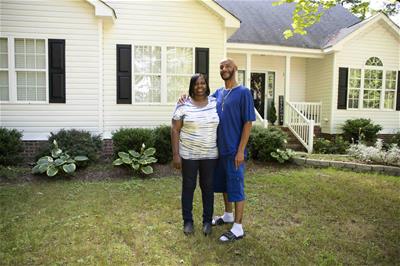
Stacey Cotton, who works in a manufacturing plant in Tarboro, NC, bought her first home with a Self-Help loan while she was single. Congratulations to her and her husband, Travis, on their recent marriage!
The homeownership rate for Black families today hasn’t changed much in the past 50 years. True or false?
Unfortunately, that statement is true. In 1970, 42% of Black families owned a home. In recent times, the homeownership rate for Black householders has hovered around 44% -- not a big difference.
Leading up to the housing crisis of 2008, Black households had been making gains in homeownership, but high-interest subprime loans, including aggressively marketed “exploding” adjustable-rate mortgages, were designed for enrichment on Wall Street, not wealth-building on Main Street. Black borrowers often received unsustainable mortgages when they could have qualified for better loans, and many Black homeowners and other people of color were targeted for predatory refinances that resulted in foreclosures.
As noted by Self-Help’s CEO, Martin Eakes, “In the seven years following the 2008 financial collapse, over $500 billion of family wealth was lost from African-American families alone. This period witnessed the greatest transfer of wealth away from Black and Latino families in history.”
Many factors continue to block economic progress today, including negative economic effects of the pandemic and the debilitating burden of heavy student debt that disproportionately affects people of color. After centuries of barriers to economic prosperity, the median net worth for a Black family is $24,100, compared to $188,200 for white families (2019 figures, Brookings Institute). This low wealth means that a down payment on a house is out of reach for many families, perpetuating the inequality that already exists.
“For too long there have been walls around homeownership,” said Shondra Tanner, Self-Help’s director of mortgage originations. “We’re here to open doors to sustainable ownership that will help families build wealth for the future.”
Putting Homeownership Within Reach – More Flexible Qualifying
Qualifying for a home loan from Self-Help isn’t easy for all applicants, because we want people to get a mortgage they can truly afford. When members come to us for a loan, we sit down together and assess their situation to determine if they’re ready to take on a mortgage. If not, we can work in partnership to develop a plan for building savings and raising credit scores.
On the other hand, we often find that people are closer to ready than they realize. Self-Help has always offered greater financing flexibility to our borrowers. Recently, we have made some changes to our underwriting guidelines that provide even more flexibility:
Student loan debt: In most cases, we can qualify borrowers based on a lower student loan payment (as low as 0) if they are on an Income-Based Driven Repayment plan.
Overall debt: Up to 50% debt-to-income ratios allowed in some cases.
Credit score: Our minimum credit score requirement is 580, and we can accept alternative credit.
Recovering from bankruptcy: Only a one-year wait after Chapter 7 or Chapter 13 discharge.
Down payment assistance: Where available, we connect our borrowers with down payment assistance, including programs offered by local, state and federal governments.
In April, our affiliate the Center for Responsible Lending released new research that underscores the challenges of buying a home. The report, “Hardship for Renters,” calculates how long it would take for renter households with varying demographics to save for a down payment and closing costs to buy a median-priced house.
CRL estimates that it would take 14 and 11 years, respectively, for Black and Latino households to save enough. For white households, the estimate is nine years. The report also finds disparities corresponding to occupation and student debt.
Waiting more than a decade is too long; the need to close the racial wealth gap is urgent. Through Self-Help’s secondary market lending, we are helping to make mortgages more affordable for thousands of families, and in our direct lending we are actively exploring ways to make affordable, sustainable mortgages more accessible to families who have faced barriers to building wealth.
If you’re interested in finding out more about a home loan, please contact your local Self-Help branch or find out more here.
Sources
“Black Americans and the Racist Architecture of Homeownership,” NPR “Code Switch” (May 8, 2021)
“Black homeownership rate hits the lowest levels since the 1960s …,” MarketWatch (March 23, 2021).
“Lost Ground, 2011: Disparities in Mortgage Lending and Foreclosures,” Center for Responsible Lending (November 2011).
“Extreme Inequality: Is it Really a Problem?” Martin Eakes, the Thomas Willis Lambeth Distinguished Lecture at the University of North Carolina – Chapel Hill (October 1, 2015).
“Hardship for Renters: Too Many Years to Save for a Down Payment and Closing Costs,” Center for Responsible Lending (April 2021).